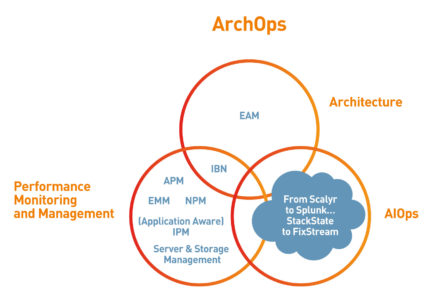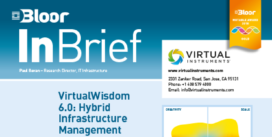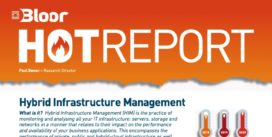ArchOps
Last Updated:
Analyst Coverage: Paul Bevan
ArchOps is a combination of tools, practices and cultural philosophies, that increases an organisation’s ability to design, implement and manage agile IT infrastructure, in a way and with a speed that enables organisations to better serve their customers and compete more effectively in the market.
The philosophy at the heart of ArchOps is very similar to DevOps, namely the breaking down of silos, this time between IT Architectural design and IT operations. This is underpinned by the recognition that the IT infrastructure must be driven by the business needs of the organisation.
The underlying technology assumptions in ArchOps are Big Software and the primacy of Artificial Intelligence (AI)/Machine Learning (ML), and Automation. Big Software represents the start of a new technological era in which each of the major capabilities at the heart of contemporary cloud and data centre operations can be created and managed as software – data storage as software, data processing as software, data networking as software. Based on a data management and compute landscape that is a single continuum of software, innovative capabilities, such as AI, ML and Automation, are now being developed to further transform IT operations management.
The complexity of today’s hybrid, multi-cloud, globally connected and edge focused infrastructure that needs to flex and change at will, is beyond the capacity of traditional tools and processes.
The IT tools for ArchOps, available today, can be broken down into three general areas:
- I.T. Architecture. This has generally been known under the term Enterprise Architecture Management (EAM). These are generally significant solutions targeted at larger IT organisations with complex architectures. The best provide insight into the existing IT portfolio and its context, enable the planning of the future IT portfolio without silos, based on the requirements of the business and, ensure all stakeholders are connected to the bigger picture. This area also includes new Intent Based Networking (IBN) solutions that combine elements of architecture design with automated implementation and management capabilities.
- I.T. Performance Monitoring and Management. There are specific domain tools such as Application Performance Monitoring (APM), Network Performance Monitoring (NPM), Endpoint Management and Monitoring (EMM) and Server and Storage Management. These have now been supplemented with tools that can monitor and manage IT infrastructure across both public and private clouds and, on-premises legacy environments. In some cases these tools are application-aware. This means that they can map and monitor applications to the specific infrastructure elements they use. Bloor uses the term Hybrid Infrastructure Management (HIM) to categorise such tools.
- AIOps. This is a relatively new term that is being applied to a wide range of new, cloud-native, tools. As the name implies, they all rely heavily on the ability of AI to analyse and remediate IT operational problems. Their heritages are diverse, covering tools whose initial focus varied from data analytics, through DevOps automation to Public Cloud Management, but who are all now converging on the ability to monitor and manage hybrid IT infrastructures.
You should care because your Board will expect IT to be able to flex and change at speed to take advantage of new business opportunities and counter potential business threats. At the same time they will be seeking assurances about the performance, security, regulatory compliance and cost effectiveness of IT.
For all the growth of public cloud and the ability for hardware and software to be delivered as-a-service, the I.T. reality for all but the digital start-ups, is a complex, hybrid one. You may well be using multiple public clouds; you might have Google Cloud Compute for big data analytics, AWS for mobile apps and Salesforce.com for example. Some systems might remain on-premises for the foreseeable future either because of data compliance concerns, or the difficulty of transitioning critical legacy systems of record to the cloud. Now, on top of that, new IoT and 5G technologies, that herald step changes in productivity, are pushing more and more systems to the edge of the network.
In this complex environment, you must decide where and how to deploy IT to support Business Services. You will have to work out what applications can be deployed to the public cloud. You will need to ensure that cloud costs don’t run out of control. You have to ensure seamless connectivity for staff, customers and partners from any device, anywhere to any application. You will be expected to deliver high levels of availability and performance to the user… and it might all change tomorrow.
Emerging tools and technologies in this ArchOps arena promise a capability to link the delivery of business services directly to the most suitable IT infrastructure; to ensure that its design meets all business governance rules, security mandates and performance requirements; to monitor and proactively manage the user experience and allow for the rapid reconfiguration of the infrastructure as the business changes.
A mutable business is in a constant state of change because it recognises that evolution is essential to its success and ultimately its survival. Now, businesses can be scaled up and down very quickly and cost-effectively. If your business model does not allow for this you will not be able to compete, over time. If you are using multiple IT management and monitoring tools that make it difficult to get to a single version of the truth and your operation is highly siloed then it follows that IT architecture and operations cannot support your business model, however flexible or mutable it is.
About the market, we believe that vendors in the areas of IT Performance Monitoring and Management, and AIOps will move their tools progressively towards an integrated ArchOps solution.
Questions have been raised about the role, and even the need for, EAM solutions and even IT Architects. That is not our position, but there is a need for EAM vendors to look at the relevance of their tools and approach in a Hybrid-Cloud environment. It is likely that architecting your data will drive, perhaps autonomously, the architecting of your infrastructure. EAM vendors should be aware of and take into consideration how they accommodate this.
Security is obviously a key concern in any IT architecture and operations environment. Just as security has been, eventually, built into the DevOps process, so it should be in ArchOps.
For IT leaders operating in a hybrid infrastructure environment there are three imperatives in assessing how to move forward with ArchOps.
- You need to ensure you have a clear view of business priorities, the sort of, and importance of business service performance metrics, which will impact the monitoring and management you put in place.
- Then, review the number and efficacy of tools you use to architect, monitor and manage your IT infrastructure. You should be asking existing vendors for their roadmaps with particular reference to their plans for AI/ML, Automation and Big Data analytics.
- Begin the process of building new IT staff capabilities and competencies and the development of new collaborative architecture and operations teams.
Downloads
- The Criticality of the Network in the Future of Business - Managing your networks for success
- VirtualWisdom 6.0: Hybrid Infrastructure Management
- Hybrid Infrastructure Management
- Instrumenting the Virtualised Datacentre … for Performance SLA’s - On the path to a single view of infrastructure performance across the enterprise
Commentary
Solutions
These organisations are also known to offer solutions:
- Accedian
- Anodot
- AppDynamics (Cisco)
- AppNeta
- Avolution
- BigPanda
- BiZZdesign
- BMC
- BOC Group
- Brains Technology
- Broadcom
- Cloud Gateway
- Colasoft
- Devo (Logtrust)
- Dynatrace
- eG Innovations
- Evolven
- ExtraHop
- FixStream
- IBM
- InfluxData
- ITRS
- JKool
- LiveAction
- LogicMonitor
- Loom Systems
- ManageEngine
- MEGA
- Micro Focus
- Microsoft
- Moogsoft
- NetScout
- New H3C Group
- New Relic
- OpsRamp
- Opsview
- Oracle
- Orbus Software
- Planview
- QualWare
- Quest
- Resolve Systems
- Riverbed
- Scalyr
- ScienceLogic
- SevOne
- SignalFx
- Software AG
- SolarWinds
- Sparx Systems
- Splunk
- Stackstate
- Sumo Logic
- Tingyun
- Uila
- UNICOM Systems
- VIAVI Solutions
- Virtana
- VNT Software
- VuNet




